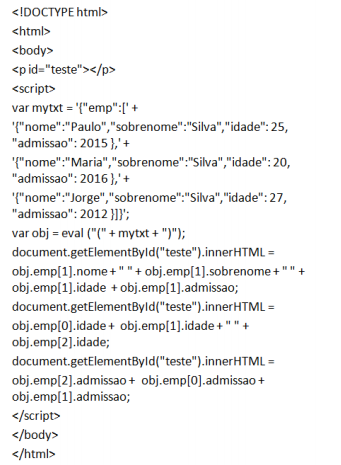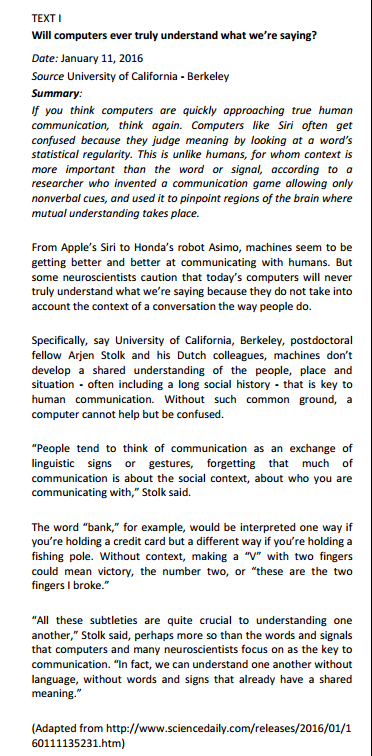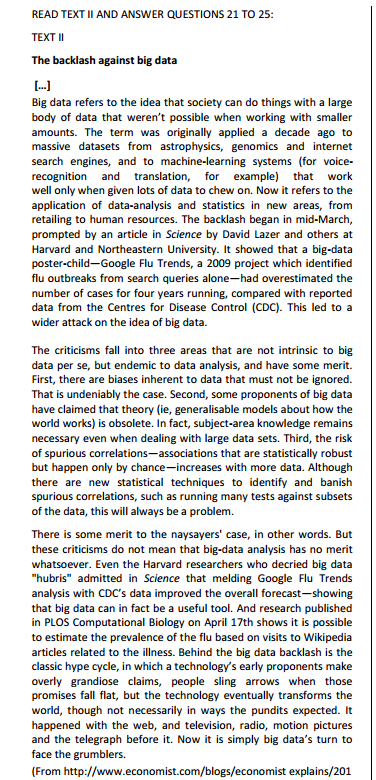Considere a página HTML, seu script e o objeto JSON:

A opção que descreve corretamente o que acontece quando a
página é carregada no navegador Google Chrome é:
operação inválida;
No contexto do Ionic (versão 1.2), quando um analista cria um novo projeto, os principais arquivos gerados pelo framework são:
The use of the phrase “the backlash” in the title of Text II means the:
Suponha que, de um baralho normal, contendo 52 cartas de quatro naipes, é extraído, sem reposição e aleatoriamente, um total de quatro cartas. Se a carta “Ás” é equivalente a uma figura (ou seja, são 4 figuras e 9 números de cada naipe), é correto afirmar que a probabilidade de que todas sejam:
Considerando-se que apenas os 10% que atinjam as maiores notas serão aprovados, a nota mínima para aprovação é:
No que tange ao regime constitucional atinente a concurso público para investidura em cargo ou emprego público, a Carta Magna prevê que:
Mariano, motorista de fundação pública federal de direito público, conduzia com as cautelas necessárias veículo oficial da entidade levando documentação de repartição regional para a sede da fundação. No meio do trajeto, o veículo foi abalroado por um motociclista que conduzia sua moto na contramão da direção e em velocidade acima do permitido para a via. O motociclista sofreu lesões corporais graves em razão do acidente, mas felizmente Mariano saiu ileso do episódio. No caso em tela, em matéria de indenização em favor do motociclista:
Com escopo de preservar o princípio da moralidade administrativa, a Constituição da República de 1988 estabelece que os atos de improbidade administrativa importarão, na forma e gradação previstas em lei:
Consoante dispõe a Lei nº 9.784/99, que regula o processo administrativo no âmbito da Administração Pública Federal, o recurso administrativo:
Em relação à licença por motivo de doença em pessoa da família, a Lei nº 8.112/90 dispõe que:
A autoridade que tiver ciência de irregularidade no serviço
público é obrigada a promover a sua apuração imediata.
Consoante dispõe a Lei nº 8.112/90, a sindicância:
READ TEXT I AND ANSWER QUESTIONS 11 TO 15
TEXT I
Will computers ever truly understand what we're saying?
Date: January 11, 2016
Source University of California - Berkeley
Summary:
If you think computers are quickly approaching true human
communication, think again. Computers like Siri often get
confused because they judge meaning by looking at a word's
statistical regularity. This is unlike humans, for whom context is
more important than the word or signal, according to a
researcher who invented a communication game allowing only
nonverbal cues, and used it to pinpoint regions of the brain where
mutual understanding takes place.
From Apple's Siri to Honda's robot Asimo, machines seem to be
getting better and better at communicating with humans. But
some neuroscientists caution that today's computers will never
truly understand what we're saying because they do not take into
account the context of a conversation the way people do.
Specifically, say University of California, Berkeley, postdoctoral
fellow Arjen Stolk and his Dutch colleagues, machines don't
develop a shared understanding of the people, place and
situation - often including a long social history - that is key to
human communication. Without such common ground, a
computer cannot help but be confused.
"People tend to think of communication as an exchange of
linguistic signs or gestures, forgetting that much of
communication is about the social context, about who you are
communicating with," Stolk said.
The word "bank," for example, would be interpreted one way if
you're holding a credit card but a different way if you're holding a
fishing pole. Without context, making a "V" with two fingers
could mean victory, the number two, or "these are the two
fingers I broke."
"All these subtleties are quite crucial to understanding one
another," Stolk said, perhaps more so than the words and signals
that computers and many neuroscientists focus on as the key to
communication. "In fact, we can understand one another without
language, without words and signs that already have a shared
meaning."
(Adapted from http://www.sciencedaily.com/releases/2016/01/1
60111135231.htm)
If you are holding a fishing pole, the word “bank” means a:
READ TEXT II AND ANSWER QUESTIONS 16 TO 20:
TEXT II
The backlash against big data
[…]
Big data refers to the idea that society can do things with a large
body of data that weren't possible when working with smaller
amounts. The term was originally applied a decade ago to
massive datasets from astrophysics, genomics and internet
search engines, and to machine-learning systems (for voicerecognition
and translation, for example) that work
well only when given lots of data to chew on. Now it refers to the
application of data-analysis and statistics in new areas, from
retailing to human resources. The backlash began in mid-March,
prompted by an article in Science by David Lazer and others at
Harvard and Northeastern University. It showed that a big-data
poster-child—Google Flu Trends, a 2009 project which identified
flu outbreaks from search queries alone—had overestimated the
number of cases for four years running, compared with reported
data from the Centres for Disease Control (CDC). This led to a
wider attack on the idea of big data.
The criticisms fall into three areas that are not intrinsic to big
data per se, but endemic to data analysis, and have some merit.
First, there are biases inherent to data that must not be ignored.
That is undeniably the case. Second, some proponents of big data
have claimed that theory (ie, generalisable models about how the
world works) is obsolete. In fact, subject-area knowledge remains
necessary even when dealing with large data sets. Third, the risk
of spurious correlations—associations that are statistically robust
but happen only by chance—increases with more data. Although
there are new statistical techniques to identify and banish
spurious correlations, such as running many tests against subsets
of the data, this will always be a problem.
There is some merit to the naysayers' case, in other words. But
these criticisms do not mean that big-data analysis has no merit
whatsoever. Even the Harvard researchers who decried big data
"hubris" admitted in Science that melding Google Flu Trends
analysis with CDC's data improved the overall forecast—showing
that big data can in fact be a useful tool. And research published
in PLOS Computational Biology on April 17th shows it is possible
to estimate the prevalence of the flu based on visits to Wikipedia
articles related to the illness. Behind the big data backlash is the
classic hype cycle, in which a technology's early proponents make
overly grandiose claims, people sling arrows when those
promises fall flat, but the technology eventually transforms the
world, though not necessarily in ways the pundits expected. It
happened with the web, and television, radio, motion pictures
and the telegraph before it. Now it is simply big data's turn to
face the grumblers.
(From http://www.economist.com/blogs/economist explains/201
4/04/economist-explains-10)
The use of the phrase “the backlash" in the title of Text II
means the:
Suponha que, de um baralho normal, contendo 52 cartas de quatro naipes, é extraído, sem reposição e aleatoriamente, um total de quatro cartas. Se a carta “Ás” é equivalente a uma figura (ou seja, são 4 figuras e 9 números de cada naipe), é correto afirmar que a probabilidade de que todas sejam:




